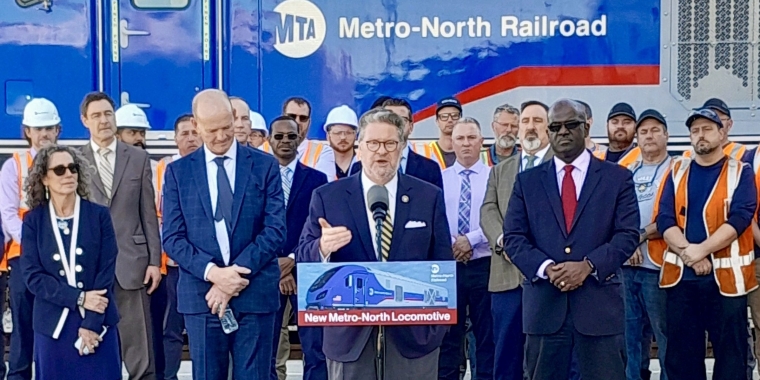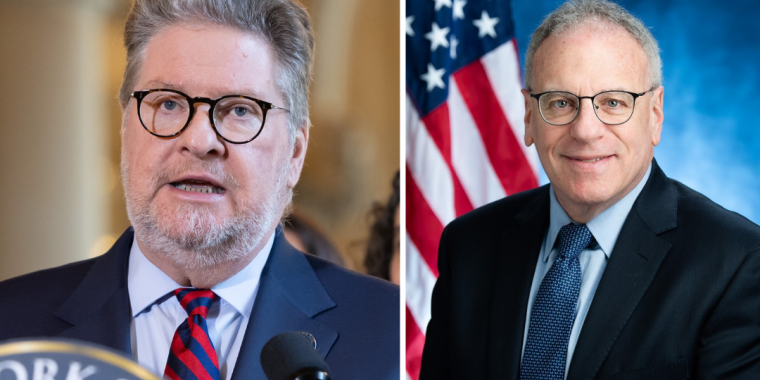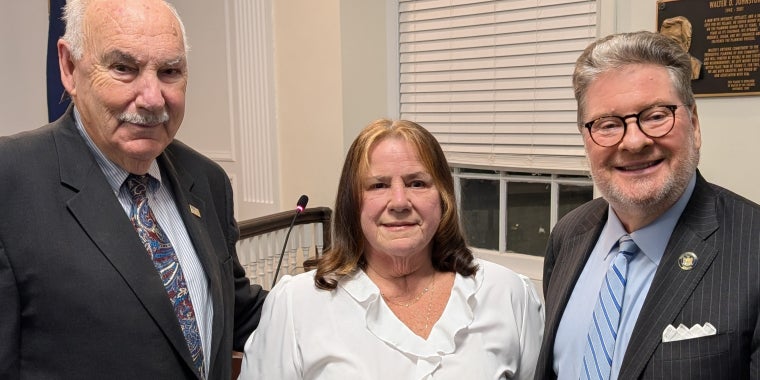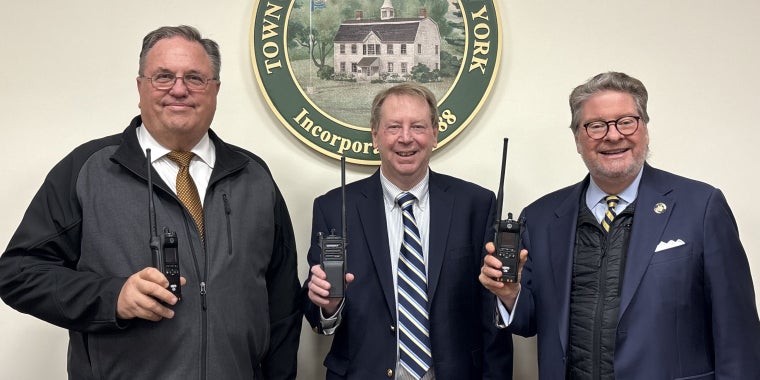
Harckham Announces Wide-Ranging Benefits of MTA Metro-North Capital Plan
May 15, 2025
-
ISSUE:
- Senator Harckham. SD40
- MTA (Metropolitan Transportation Authority)
- Metro-North Railroad
- MTA Funding
- 2025-2026 State Budget

State Sen. Pete Harckham during a recent event and visit at Metro-North Railroad’s Harmon Shop in Croton-on-Hudson, NY
Peekskill, NY - In recognition of National Transportation Week, which takes place this year between May 11 – 17, New York State Senator Pete Harckham announced today that State Budget funding for the $68.4 billion capital plan of the Metropolitan Transit Authority (MTA) will have economic, climate and quality-of-life benefits for the Metro-North Railroad service area and the rest of the Hudson Valley. Most importantly, these investments will protect the system from rising sea levels due to climate change while improving commutation for travelers across the 40th Senate District.
“A fully-funded MTA capital plan is not just about tracks and trains—it is investing in the economic vitality of our Hudson Valley communities,” Harckham said. “The strategic investments in the MTA capital plan will help ensure our residents can reliably access jobs, and that our local employers have the workers they need to serve our residents.”
While there are certain funding uncertainties, the recently enacted FY2025-2026 State Budget allocated $1.4 billion in annual revenues to help finance the MTA’s five-year capital plan, which includes $6 billion in investments to Metro-North Railroad. The railroad plans to purchase new railcars, improve its outlying stations, build resilience into its rail lines and begin a major reconstruction of the vital Park Avenue underground approach to Grand Central Terminal.
According to the Partnership for New York City (PFNYC), the direct expenditure proposed in the capital plan will generate $106 billion of statewide economic output over five years, supporting an average of 72,000 jobs during that period.
“Independent research commissioned by the Partnership indicates that the fully-funded MTA capital plan is a ‘win-win’ that will not only catalyze critical improvements in transit service but also provide a major boost to the state’s economy, generating $6.1 billion in GDP and contributing more than 9,000 jobs in the Hudson Valley alone,” said Kathryn Wylde, President & CEO of PFNYC. The region is third after New York City and Long Island to benefit most from the program of investment, according to the organization.
Harckham said that investments in Metro-North will benefit its 255,200 daily riders, including many “reverse” commuters, who travel to jobs in Westchester and Putnam counties and help to contribute to economic growth in those areas, including healthcare facilities.
Maurice Brown, Political Director, the Hudson Valley and Capital Region, 1199 SEIU, said, “Thousands of members of 1199 SEIU commute to healthcare jobs across Westchester and Putnam Counties and the Lower Hudson and Catskill regions. This critical boost to the MTA is an investment in easier, faster commutes, better quality of life, less congestion, and healthier communities. We applaud Senator Harckham’s leadership in the effort.”
“Long-term investments in public transit infrastructure are vital for our team members at Northern Westchester Hospital, ensuring they have reliable and efficient transportation options,” said Derek Anderson, President, Northern Westchester Hospital. “This commitment not only supports our workforce but also strengthens the broader health and well-being of the communities we serve. Thank you to Senator Harckham for prioritizing the future of Westchester in the state budget and subsequent MTA capital plan.”
In addition to economic benefits, the MTA capital plan will continue to help reduce toxic vehicle emissions that impact health and climate. A single Metro-North Harlem or Hudson line 10-car train can potentially take more than 1,000 cars off the road. MTA subways, buses and trains help avoid over 36 million vehicle miles being driven on an average weekday—about 10.2 billion miles a year. This saves the region more than 20 million metric tons of carbon emissions annually, which is the equivalent to the amount of carbon absorbed by a forest the size of Indiana, according to the MTA.
To address the some of the direct impacts of climate, Metro-North says it plans to spend $800 million to address flooding on the Hudson Line, including a 20-mile stretch between Riverdale and Croton-Harmon, which is vulnerable to extreme weather. The line has been seriously disrupted several times in recent years by flooding as a result of extreme weather events.
“There is no public infrastructure more important to our region’s environment or economy greater than the MTA, which is why it requires a fully-funded capital program,’ said Jaqi Cohen, Director of Climate and Equity Policy at the Tri-State Transportation Campaign. “By investing in sustainable upgrades, like electrifying buses and fortifying subways and commuter rail against climate-related flooding, the capital program will reduce carbon emissions, improve air quality, and protect our infrastructure from the growing threats of climate change. A fully-funded capital program for the MTA means a more resilient and better connected future for the entire tri-state region.”
The railroad says the plan allocates $1 billion to station design and construction, including the Chappaqua, Golden’s Bridge, Purdy’s, Croton Falls, and Brewster stations, as well as the redesign of the Mount Kisco, Bedford Hills, Katonah, and Southeast stations. The funding will also enable the railroad to rehabilitate the parking lot at the Patterson station, as well as replace the elevator cab at the Peekskill station.
Additionally, the railroad will spend almost $1.7 billion to replace its 40-year-old M3 Harlem and Hudson lines electric passenger cars and fund the design of a new generation of locomotive hauled passengers cars to replace the ones that have served riders to Poughkeepsie and Wassaic for more than four decades. The railroad will also add new climate-friendly locomotives to the two Metro-North lines that serve Rockland County.
The planned Grand Central Artery project is also an important benefit to Westchester and Putnam riders because it is the jugular of the Metro-North system, allowing access to Grand Central Terminal to a quarter million riders a day. The railroad plans to invest more than $1.7 billion to rebuild this vital transportation link.
“For too long, our vast transit system, the lifeline of our region, was neglected,” Harckham said. “We must continue to invest in this system because our residents and businesses depend on safe, affordable and reliable transportation.”



